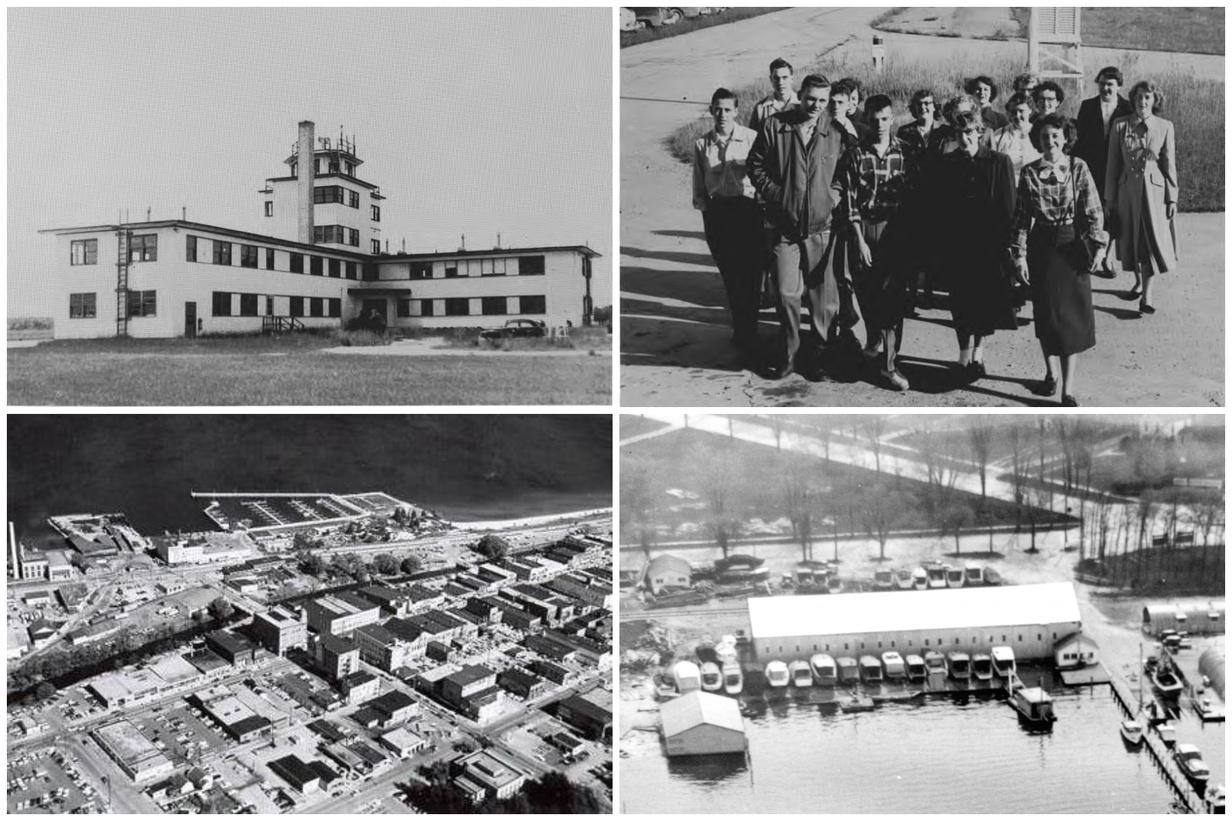
The Gamechangers, Part 1: Post-War Growth Prompts Big Transformations In Traverse City
By Craig Manning | April 3, 2022
Which events most shaped Traverse City as we know it today?
2022 marks 175 years since the 1847 establishment of Traverse City. To commemorate the occasion, The Ticker is taking a closer look at how the place we call home took form across the decades. Over the coming weeks, we will delve into one decade at a time, highlighting two game-changing occurrences from each 10-year span that fundamentally shaped the future of Traverse City. Our starting point? The 1950s, the decade where – on the heels of both World War II and a centennial milestone – the modern Traverse City began to come into focus.
1951: Northwestern Michigan College (NMC) is born
Preston N. Tanis, who served as NMC’s first director from 1951 to 1967, detailed the full story of the college’s early days in the 1973 book, Northwestern Michigan College: The First Twenty Years.
According to Tanis, the Traverse City Chamber of Commerce tried numerous times throughout the 1930s and 1940s to get the ball rolling on local higher education, but ran into roadblocks. First, in the wake of the Great Depression, there was no feasible way to finance a new college. Then, in 1940, just as the local school board started working to create junior college programming, war broke out and put the project on hold. State law also required “a minimum population base for the establishment of a two-year college,” and Traverse City did not meet the requirement.
After the war, conversations about bringing a college to northern Michigan resumed. The population was growing, there was an uptick in local business activity, and there was demonstrable interest in adult education. The superintendent of schools at the time, Glenn Loomis, had initiated an adult education program in 1944, and enrollment had exploded after the war. By 1950, there were “over 2,500 people [participating] in some 100 technical, vocational, and cultural courses.”
The driving force of the local college effort proved to be Les Biederman, a Philadelphia native who had moved to Traverse City in 1940 and launched WTCM, the area’s first radio station. In the fall of 1950, Biedermen invited a cadre of community leaders to the Park Place Hotel for dinner. He came armed with data to illustrate the need for local higher education, sharing statistics about how many local high school graduates couldn’t afford to go away to college – and how many who left for college didn’t come back. He ultimately convinced his guests that now was the time to move beyond talk to action, and the group mobilized.
There were still hurdles ahead. Most pressingly, the Michigan Junior College Law still had a population base requirement, and Traverse City still wasn’t big enough to meet it. Biederman, with legal counsel from attorney Harry Running and assistance from state representative Arnell Engstrom, lobbied the Michigan legislature’s education committee to change the law. That advocacy led to the passage of Public Act 189 in the spring of 1951, which formally created a brand-new type of educational institution in the state of Michigan: the community college.
Another hurdle was money. NMC received no large endowments or gifts, no land grants from the state, and no other state appropriations. Instead, funds to start the college were raised through a Chamber of Commerce campaign, which came to be known as the “Founders’ Fund Drive.” The chamber enticed locals to contribute money by promising that anyone who donated $100 or more would be classified as a “Founder of the College.” All told, approximately 400 area residents contributed a combined $40,000 to bring the college to fruition.
The last major challenge was finding a home for the new school. One day, on a flight into Traverse City, Biederman spotted a city-owned terminal building that was largely underutilized. According to Tanis, Biederman “forced locks with his pocket knife” to break into the building, where he “found several rooms which he decided could easily be converted into college use.” The city commission agreed to loan two wings of the building to NMC, rent-free, for at least the first year.
Thus, the Traverse City Airport Building (pictured, top left) became the first home of the college; it would remain NMC’s hub until 1955. 65 students from 21 northern Michigan communities arrived at the building on the morning of September 15, 1951 for the first day of classes (pictured, top right).
1952: Grandview Parkway opens
Grandview Parkway has been in the news lately as the Michigan Department of Transportation (MDOT) has begun plotting a 2023 reconstruction of the trunkline. This year marks 70 years since it first opened.
Conversations about Grandview Parkway actually began in 1940, prompted by an increasingly crowded and congested downtown. Local leaders wanted to alleviate the problem by directing traffic from US 31 elsewhere. At the time, the highway route ran north into town on Rennie (now Veterans Drive), turned right (east) at 14th Street, turned left (north) on Union, and then turned right and ran east along Front Street. Once built, the Parkway would allow the route to be directed north up Division and then east along Grandview. (Pictured bottom left is the Parkway in its early days.)
Crucially, the construction of the Parkway required significant dredging of the Grand Traverse Bay, to create more space along the waterfront. According to the Traverse Area Historical Society, roads like Bay Street used to be considerably closer to the water, with a marina even located directly north of the Bay Street/Monroe Street intersection (pictured, bottom right). Dredging allowed the city to expand its own bayfront landmass, and to create a base on which Grandview Parkway could be built. The construction also required the relocation of the mouth of the Boardman River, which was moved slightly west of its natural location. Per the Historical Society, the Boardman used to flow through what is now the rear parking area of the Delamar.
In addition to relieving congestion downtown, Grandview Parkway may have been crucial in paving the way for the transformation of Traverse City’s bayfront. Before the road was built, the waterfront was populated mostly by industrial buildings. The state tore down many of those structures while building Grandview Parkway, and Russ Soyring, who served as city planner from 1986 until his retirement last year, has previously said that the construction of the Parkway was critical in getting people talking about creating more parks and public spaces along the waterfront. It would take half a century before the last remnant of the industrial waterfront, the city power plant, was removed; that structure was finally demolished in 2005.
Comment






